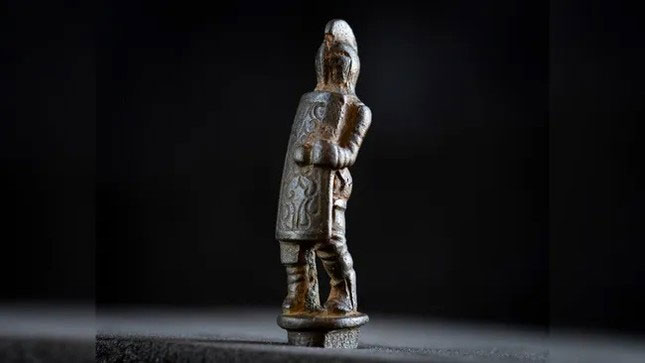Rare gladiator knife handle found on Hadrian's Wall
It's rare to find gladiator memorabilia from Roman Britain, but archaeologists at Hadrian's Wall in Northumberland, England, have just found a 2,000-year-old knife handle depicting a left-handed gladiator.
Archaeologists in England have discovered a rare 2,000-year-old Roman knife handle shaped like a gladiator, proving that the fame of these iconic warriors extended far beyond the outer boundaries of the Roman Empire. The discovery comes just in time for the release of the highly anticipated film "Gladiator II . "

A Roman dagger handle depicting a gladiator secutor found at the Roman town of Corbridge on Hadrian's Wall in Northumberland, England. (Photo: English Heritage).
The handle is made of bronze alloy and depicts a gladiator wearing a helmet and holding a shield. This figurine represents the secutor gladiator , a type of heavily armed warrior whose name comes from the Latin for "pursuer" or "pursuer" and specialized in close combat with the retiarius, a more agile type of gladiator armed with a net and trident.
This gladiator statue is left-handed. According to a statement from English Heritage, the charity that oversees historic sites in the UK, left-handed gladiators were considered unlucky, although some were trained to fight with their left hand for a unique advantage. In this case, the researchers suggest that the feature may mean the gladiator represents a specific gladiator rather than a symbolic warrior.
In ancient Rome, gladiatorial combat, or games, was one of the most popular forms of public entertainment. The gladiators were often slaves or convicted criminals, and the fights sometimes ended in the death of a gladiator. The games were held by members of the Roman elite, including the emperor himself, to show off their wealth, celebrate special occasions, and entertain themselves. Although the Colosseum in Rome is the most famous arena to host the games, they were formally held throughout the empire from 105 BC to AD 404.
'Despite being enslaved and socially outcast because of their profession, gladiators could still become celebrities,' said Frances McIntosh, Curator of Hadrian's Wall Collection and English Heritage.
The knife handle is apparently a Roman gladiator relic , the statement said . While well-documented gladiator relics include pottery, cups, lamps and figurines, this is a rare archaeological find in Britain. The find highlights how widespread the craze for gladiators was.
"Even now, nearly two thousand years later, the fascination with gladiators persists and has even spread further into modern popular culture, as evidenced by the excitement surrounding the Gladiator film sequel, " McIntosh added.
- The truth about the 'standard body' of the ancient gladiator
- Use knives every day, but are you sure you know all the benefits of each?
- Video: How does a knife maker's day take place?
- Gladiator - Roman symbol of sex
- NASA makes super durable, self-sharpening knives for under $ 100
- Discover the 'whole vegetable' diet of ancient Roman gladiators
- Instructions on how to sharpen a standard knife as an expert
- Why does the ancient Roman gladiator statue have a strange posture?
- He makes a scalpel that identifies cancerous tumors
- Knife made from feces: The improvisation of man or the big trick in 20 years?
- The legend of the gladiator at the Roman villa
- Digital multifunction knife
 Discovered an ancient centipede fossil 99 million years old
Discovered an ancient centipede fossil 99 million years old Discovered bat-like dinosaurs in China
Discovered bat-like dinosaurs in China Discovered a 200-year-old bronze cannon of the coast
Discovered a 200-year-old bronze cannon of the coast Discover 305 million-year-old spider fossils
Discover 305 million-year-old spider fossils